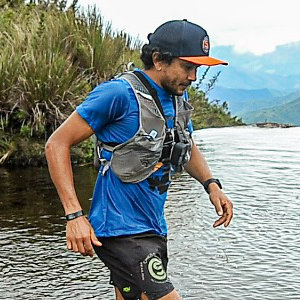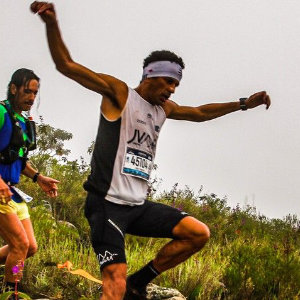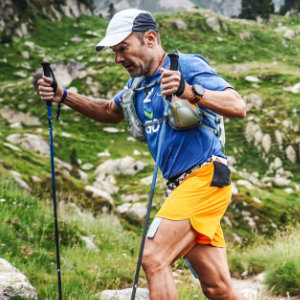In this article, we will conduct an in-depth evaluation on how to choose trail running shoes, but it’s important that you know all the necessary items before deciding which model is ideal for you.
When searching for trail running shoes, it’s very likely you’ll get lost among so many options. The trail running shoe market has grown significantly in recent years to meet the demands of an increasing number of practitioners and the specificities of available races. New technologies are also frequently launched by brands such as Salomon, HOKA, Columbia, The North Face, among others, which offer a wide range of options.
Amidst so many varieties, one of the initial criteria for choosing a shoe that provides comfort and safety should be the same as for any sport: foot type and suitability for the activity. However, to choose the ideal trail running shoe, you must consider more complex factors, such as terrain type and elevation, as well as the distance you intend to cover.
André Medeiros, athlete and coach, often makes an analogy with Formula 1 races to help his students understand the choices involved in selecting the ideal trail running shoe: “The cars will race on the same track, which is the same for everyone, and depending on the day’s temperature and weather, each car will adapt to the situation and use a specific type of tire. The same happens with running shoes. You need to know where they will be used,” explains André.
Considering these factors, the first step is to ask yourself: what is my goal? What type of trail running races do I plan to do?
Characteristics of Trail Running Races
Three main factors that guide training and competitions in trail running:
Terrain Type
During races, you may traverse dirt roads, sand, technical terrains with many rocks, narrow trails, holes, river crossings, in addition to the traditional ascents and descents.
Race Distance
Like terrain, distance should also be considered when choosing shoes. For long-distance races, cushioning, for example, is essential to ensure comfort and prevent injuries.
Climate and Temperature
It’s common to face challenging terrains in races in Brazil, with lots of mud or even rain during the course, which may require shoes with better grip to ensure safety. In races outside the country, you may even encounter snow along the way.
What to Consider When Choosing Trail Running Shoes
1. Comfort
Whether in short or long-distance races, having comfortable feet is essential to face the irregular terrains characteristic of trail running races. In this aspect, the recommendation is to evaluate the shoe’s mesh, upper, seams, as well as the shape, which may vary from one brand to another.
Virginio, athlete and coach
André Medeiros often asks his students the following questions: which shoes do you use for road running? Which brand do you prefer? “If the person answers that they like Nike, for example, if it’s a brand that brings comfort to their feet, I think it’s worth looking into Nike’s specific trail running shoes, because the profile and geometry don’t change much,” he explains.
Another characteristic to evaluate for comfort is the shoe’s mesh. “It should be breathable to prevent overheating of the feet, considering the climate we have in Brazil. It’s also important to check if mud and other dirt come off easily from the shoe, avoiding weight gain. Recently, I ran a race in Passa Quatro, Minas Gerais, with lots of mud. I was wearing the Vectiv Enduris 3 from The North Face, and the mud came right off when I tapped my foot. I finished the race with nothing stuck to the shoes,” says Rosália Camargo, ultramarathoner. This point is also noted by athlete Ivania Rambo: “I evaluate the shoe a lot when stepping in mud to see if it will stick. The goal is for it to come off easily so it doesn’t hinder our performance in the race.”

The shoes should also be chosen to be resistant but without hurting toes and nails or causing blisters. “Very stiff shoes harm the feet. In very long descents—some races have descents of up to 10 km—the impact on your toes at the front of the shoe is enormous. If you’re not careful, you can finish with destroyed feet,” warns Isadora Martins. According to the athlete and coach, it’s also ideal to evaluate the shoe’s seams, as well as the chosen size. “A 50 km race can sometimes last from 10 to 14 hours. That’s a lot of exposure time, and your feet will swell. So, you also need to be careful not to buy shoes that fit exactly. It’s recommended to choose pairs half a size or even a full size larger,” adds Isadora.
2. Grippy Outsoles
Rosalia Camargo
One of the main differences between trail running shoes and road running shoes is the non-slip outsoles that feature a kind of claws or lugs, called grip, which vary in size and height: the lower grip is mainly found in so-called hybrid shoes, which work for both trails and dirt roads, while the medium grip is indicated for those who traverse technical terrains. The larger ones are designed for more severe terrains, with predominantly long muddy stretches.
Choosing shoes considering the grip and the type of race directly affects performance during runs. “Shoes without proper grip can lead to a lack of confidence in advancing at speed or insecurity on a descent, for example, making the run slower. The opposite also applies: wearing very robust shoes with high lugs in races that don’t require such characteristics can make the run more rigid,” explains Virginio.
Isadora Martins’ tip for people who will participate in highly sought-after races, such as INDOMIT or La Mission, which have more demanding terrains, is to invest in shoes with good medium grip. The coach recommends to her students the Columbia Women’s Montrail™ Trinity™ FTK, also available in the men’s model: Columbia Men’s Montrail™ Trinity™ FTK.
Isadora also gives a warning about choosing hybrid shoes, which have low grip. “The model was designed to perform well on both roads and mountains, but running with these shoes on the road can compromise the grip, which will negatively impact your run on terrains with many loose stones, mud, etc. Now, if you prefer to do more races on dirt roads that aren’t so technical, it’s worth investing in more hybrid shoes.”
In Brazil, according to the athletes, it’s very common to have races with excessive mud after heavy rain periods. In these cases, athlete Chico Santos recommends shoes with few but high lugs spread across the outsole. “In the last three or four years, INDOMIT, which takes place at Pedra do Baú, had a lot of mud. Having appropriate shoes with high grip makes all the difference. If you’re wearing shoes with low lugs, you won’t be safe. Wherever you step, you risk slipping. Besides, the effort you’ll make to balance yourself and not fall is very high, so the wear and tear in a 50 km race can be significant. If you have mud shoes, you’ll gain between 15 and 20 minutes in movement,” recommends Chico, who currently uses the S/LAB SPEED 2 from Salomon to face the most severe terrains.
3. Cushioning
Cushioning is a strong ally of comfort, especially when you choose long-distance races with rocky terrains and asphalt sections. It helps prevent injuries, sprains, and protects the feet from excessive friction caused by long-duration runs.
For shorter races, according to athlete Chico Santos, a more minimalist shoe may perform better. “When you seek more performance at high speed on the ground, you get a better response with shoes that have less cushioning. Currently, we have VK (vertical kilometer) races, for example, where you run between 5 and 6 km with 1 km of ascent. In this case, shoes that respond as quickly as possible are recommended,” he explains.
Tip: On the Hoka website, the shoes specify the cushioning, classifying it as balanced, responsive, or plush.
Choosing the Right Trail Running Shoes Helps Prevent Injuries
In addition to blisters and toenail loss pointed out by Isadora Martins, which can happen with very stiff shoes, it’s important to be aware of the risk of more serious injuries caused by inappropriate footwear.
When she started trail running, Ivania Rambo chose to use a shoe model with little cushioning, which led to complications. “At first, I thought I had to wear lightweight shoes to perform better, to seek the best performance. I was focused on pace. So, I participated in a race with very low shoes that hurt me a lot. They were super light, and I had adapted well to them, but the injuries started coming due to lack of cushioning. I started doing physical therapy twice a week, and nothing improved. Then, the physical therapist asked me to bring my shoes and suggested switching to a heavier model with more cushioning. It was either that or more injuries!” recalls the athlete.
For André Medeiros, the complications arose from not considering his foot type. “I bought a shoe model that favors pronation, but I have supination. As I started heavy training, I began to feel a very strong pain in my tibia. When I checked, I had a stress fracture injury.” As with Ivania, the discovery came through his physical therapist. “He suggested changing shoes, running, and then calling him to report. I switched to a Salomon shoe with neutral characteristics and never had problems again,” warns André.
If Possible, Have More Than One Pair of Shoes
Chico Santos
Investing in multiple pairs of trail running shoes, considering terrain type, race, and climate suitability, may not be accessible to everyone, but the athletes’ recommendation is to do so if possible.
“The ideal is to invest in two pairs: one very good for races and preparation training, and another for daily training, which can be more affordable. I know not everyone can do this, but I think it’s an excellent strategy, including to avoid wearing out race shoes,” says coach and athlete André Medeiros.
Another relevant issue regarding shoe rotation is preserving the grip, which can be compromised if frequently used on asphalt. “I went through a phase where I only used trail shoes for road running, which was ruining the grip. So, I think a care you must take is to keep trail shoes only for trails,” says Isadora Martins. An alternative proposed by the coach and athlete is to use shoes that have already been used in races and have more worn-out grip but are still in good general condition for road running.
For Virginio, it’s important for trail runners to know that shoes wear out faster compared to road running shoes. “The ideal is to have an entry-level shoe for beginners but also think about a high-quality, technologically advanced model for races. I use the S/LAB Ultra 3 from Salomon, which works for me in the mountains. It’s a very comfortable shoe for me,” recommends the athlete.
Rosalia Camargo says that the strategy of having more than one pair of shoes also helps her in races. “Recently, I ran a 100-mile race where I alternated between three pairs of The North Face shoes, two Vectiv Enduris 2 models and one Vectiv Enduris 3. I like to do this in long races because sometimes, when the shoes start to rub a little on the little toe on the left side, you change shoes and shift the contact area of friction with your feet,” she says.
Meet the Shoes Recommended by the Athletes

Ivania Rambo
Gaúcha ultramarathon champion who achieved the best ITRA (International Trail Running Association) scores in 2023.
“For very long distances, like ultramarathons, we have to prioritize cushioning and comfort a lot. Today, I have six pairs of the same model, the Columbia Montrail Trinity FKT, which I use for everything. It grips well on all terrains, holds where it needs to hold.”

Isadora Martins
Ultramarathoner, personal trainer, yoga instructor, and running coach at the Projeto SANA sports agency. Creator of the Elas na Trilha project.
“I’ve been using the Columbia Montrail Trinity FKT for years. I’ve never had a blister. It gives me the ideal comfort for running. I recommend it to all my students. It performs well in the most sought-after races.”

Rosalia Camargo
Ultramarathoner, champion of several national and international races. Author of the books Pelas Trilhas and 100 Milhas.
“In races up to 50 km, I use the Vectiv from The North Face, with a carbon plate. It provides speed while the fabric is great because it doesn’t collect dirt or sand and is highly breathable. For longer races, I use the Vectiv Enduris 3, which has more cushioning and gives me more comfort.”

Chico Santos
Mountain running athlete with extensive experience in races from 50 to 130 km, and founder of CS Experience, focused on sports tourism.
“Currently, I’m using the Hoka Torrent 2 Men’s Shoes, which has good cushioning. For muddy races, I use the S/LAB SPEED 2 from Salomon, which I’ve been using for a long time, and I feel safe with it. I’ve also used the La Sportiva brand, which is less accessible in Brazil. Its main characteristic is durability. Its shoes are resistant on terrains with many rocks and mud.”

Virginio
Champion of several national and international races. Specialist in training for mountain runners, he is the technical director of JVM Trail Run.
“I vary my shoes a lot depending on the terrains and other characteristics of each race. On dirt roads, I use the Trail model from Olympikus; when it’s wet, I use the Flow 2 from Salomon. On dry technical trails, the S/LAB – 8 from Salomon, and the Ultra Vertical from The North Face when it’s wet. On rocky trails and roads, I prefer the S/LAB Ultra 3 from Salomon.”

André Medeiros
Athlete, national tour guide, and manager of the CamelBak Outdoor Sports agency.
“Hoka is the brand I’ve used the most in recent UTMB races. It provides me, at 50 years old, with a lot of comfort. Their shoes look big, seem heavy, but are very light. The brand uses a Vibram outsole, which offers a lot of safety on rocky terrains. I highlight the Mafate Speed 4, Speedgoat 5, and Challenger 7 models. Another brand I really like is Altra, famous in North America and growing in Europe as well. The shoes have a shape close to our feet, leaving the toes freer. I recommend the Timp 5 and Mont Blanc Carbon models.”
André also highlights the Cascadia 17 and Catamount 3 models from Brooks; the Gel Trabuco 12 and Trabuco Max from Asics; and the Fresh Foam X Hierro V8 from New Balance.
Recommendations and Practical Tips for Choosing Your Trail Running Shoes
Checklist for Choosing Trail Running Shoes
- Evaluate comfort and cushioning;
- Consider your foot type;
- Opt for breathable fabrics;
- Choose the grip that suits the terrain type and weather conditions of your preferred race.
Test the Shoes Before Any Race
The athletes warn that testing shoes before races is essential to ensure good performance and peace of mind during the run. The first step is to buy shoes in physical stores, not online. “We’ve lost the habit of doing this, but it’s essential to have a more complete evaluation before purchasing,” says Isadora Martins.
The second step is to put the shoes to the test. The testing time may vary from runner to runner. For Ivania Rambo, for example, at least 4 or 5 uses on different terrains are necessary. Chico Santos, an athlete used to running long distances, likes to test shoes for 50 km or even 100 km when he doesn’t know the model, to check if it really meets all his needs. “Currently, shoes are very comfortable, so maybe you don’t need that much mileage. But I like to test this way to feel the entire expandable part of the shoe in relation to what I want,” he explains.
4 Tips to Preserve Your Trail Running Shoes
Running on trails with rocks, roots, and other natural obstacles causes more wear and tear on shoes than road running, but some essential care helps preserve the footwear. Check out 4 tips:
1. Don’t Wash Shoes in Washing Machines
Although it may seem more practical, washing shoes in machines can damage them and reduce their lifespan. Opt for hand washing with neutral soap.
2. Evaluate If It’s the Right Time to Wash Your Shoes
The main goal of washing shoes is to remove sweat, which harms the footwear, as well as accumulated dirt. But it’s important to assess after each training session whether it’s necessary to expose the shoes to water. “During the week, I do a good cleaning of the shoes without soaking them. On weekends, after long training sessions, I wash them inside and out with water and detergent,” says Ivania Rambo.
3. Choose a Well-Ventilated Place to Store Your Shoes
Shoes need to breathe to avoid fungi and bacteria. Therefore, avoid storing them in boxes or cabinets. After washing, shoes should also be air-dried, but avoid leaving them exposed to the sun for too long.
4. Take Advantage of Post-Training or Post-Race Showers to Wash Your Shoes
“When I finish a race, I take the shoes to the shower, remove the insoles, and scrub them with a brush,” says Rosalia Camargo.
This post is also available in: Português (Portuguese (Brazil)) Español (Spanish)
